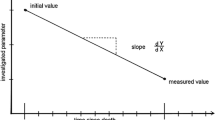Abstract
Dystrophic lesions of the gastric mucosa were observed to be formed and the pepsinogen content was reduced by 57% in the gastric mucosa of rats exposed to various experimental stressors (immobilization with electrical stimulation, immobilization at 6°C, trauma to or ligation of the pylorus). and the changes correlated with the degree of injury to the stomach. Pharmacological blockade of H2 receptors by cimetidine (100 μmoles/kg) and methiamide (410 μmoles/kg) largely prevented the formation of experimental ulcers and the decrease in the pepsinogen level. The results indicate that endogenous histamine participates in the mechanism of formation of dystrophic gastric lesions.
Similar content being viewed by others
Literature Cited
S. V. Anichkov, I. S. Zavodskaya, E. V. Moreva, et al., in: Neurogenic Dystrophies and Pharmacotherapy [in Russian], Leningrad (1969), p. 56.
S. V. Anichkov, The Selective Action of Mediators [in Russian] Leningrad (1974), p. 212.
L. L. Grechishkin and T. K. Mustafina, Byull. Éksp. Biol. Med., No. 3, 31 (1970).
I. S. Zavodskaya, Byull. Éksp. Biol. Med., No. 1, 26 (1954).
O. N. Zabrodin, Annual Report of the Institute of Experimental Medicine for 1961–1962 [in Russian], Vol. 7–8, Leningrad (1963), p. 212.
R. B. Strelkov, A Method of Calculating Standard Error and Confidence Intervals, of Arithmetic Means by Means of a Table [in Russian], Sukhumi (1966).
M. L. Anson and A. E. Myrsky, J. Gen. Physiol.,16, 69 (1932–1933).
R. I. Bersimbaev, S. V. Argutinskaya, and R. I. Salganik, Experientia,27, 1389 (1971).
J. Bugajski, J. Hano, and L. Danek, Eur. J. Pharmacol.,36, 237 (1976).
L. R. Dragstedt, in: Surgery of the Stomach and Duodenum, Boston (1962), p. 461.
L. L. Grechishkin, Pharmacology,13, 260 (1975).
D. J. Hetzel, G. J. Taggart, J. Hansky, et al., Med. J. Aust.,1, 317 (1977).
S. J. Konturek, T. Demitrescu, T. Radecki, et al., in: International Symposium on Histamine H2 Receptor Antagonists, London (1973), p. 247.
S. J. Konturek, T. Radecki, T. Demitrescu, et al., Digestion,10, 267 (1974).
C. Richardson, B. A. Bailey, J. Walsh, et al., J. Clin. Invest.,55, 536 (1975).
Rights and permissions
About this article
Cite this article
Gavroskaya, L.K., Agranovskaya, I.Y. Role of histamine H2 receptors in the mechanism of formation of experimental gastric ulcers induced in rats by various stressors. Bull Exp Biol Med 88, 841–843 (1979). https://doi.org/10.1007/BF00869209
Received:
Issue Date:
DOI: https://doi.org/10.1007/BF00869209




